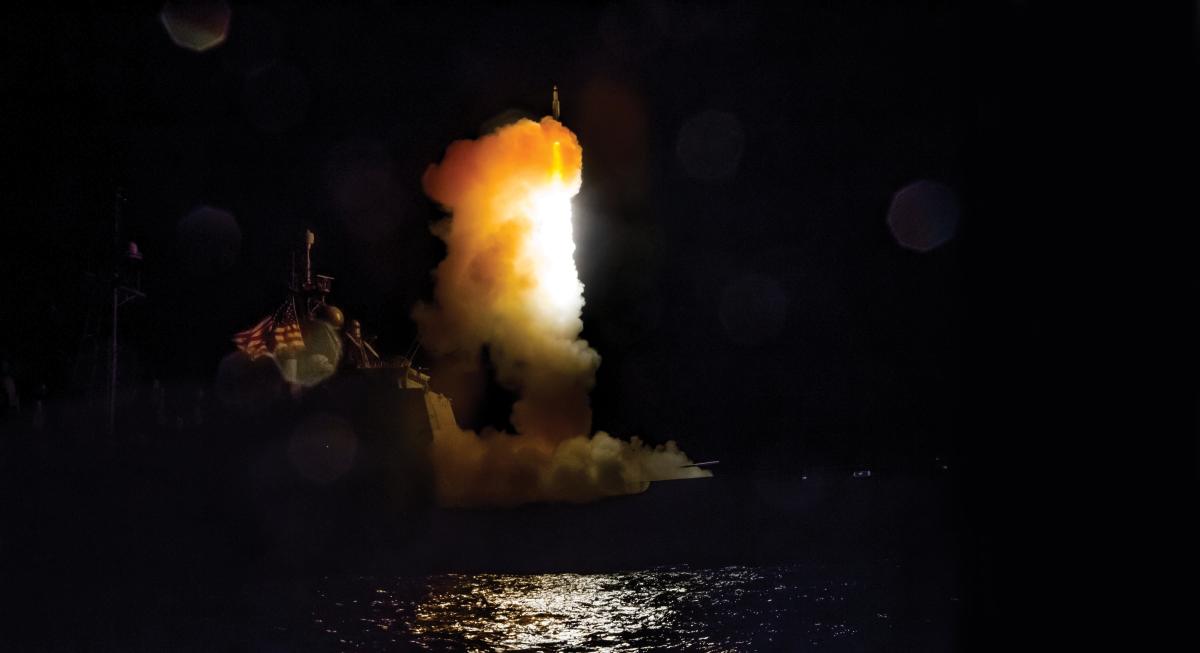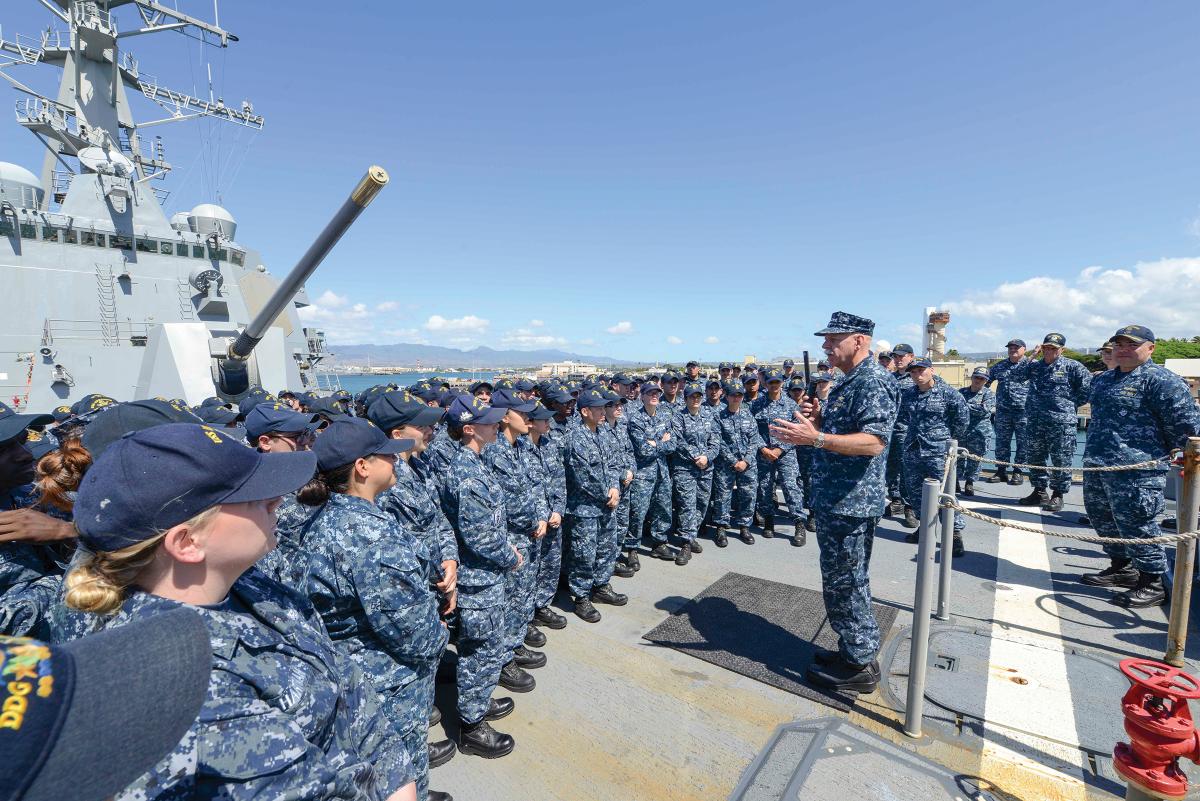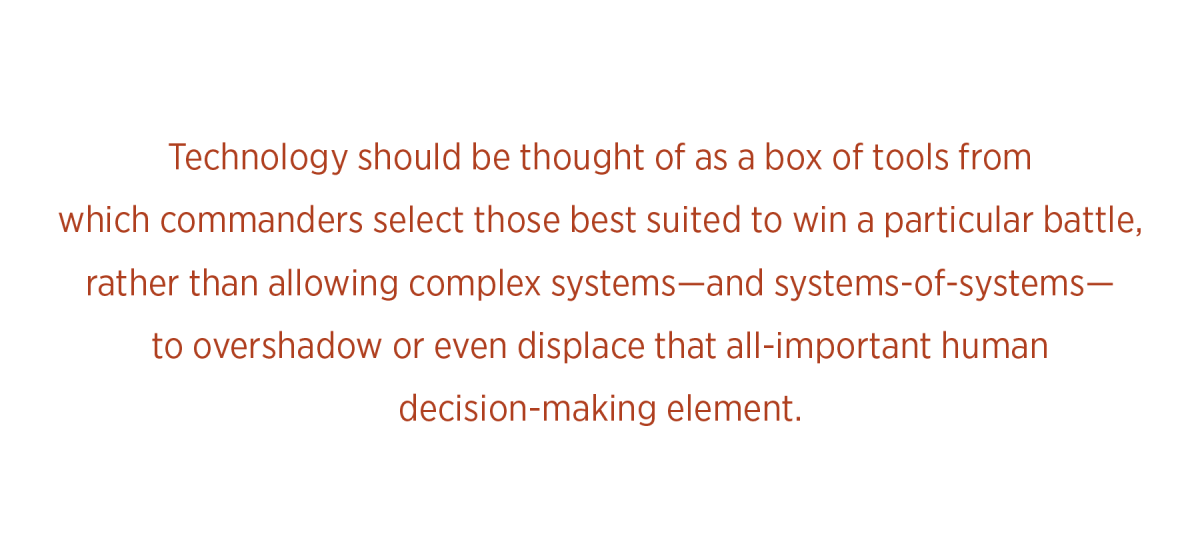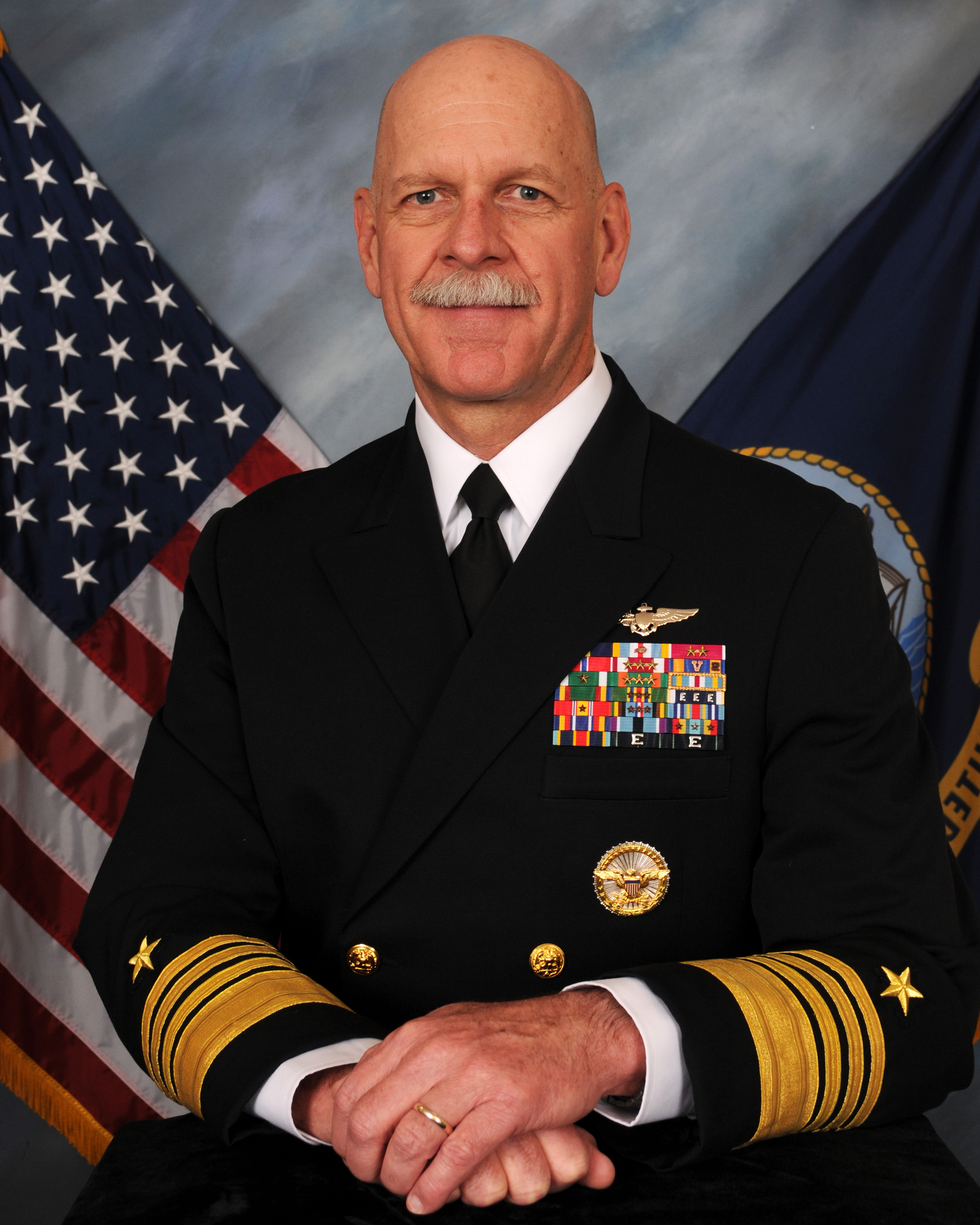Military leaders face an ever-widening array of increasingly powerful threats to their forces, missions, and countries. The acceleration and proliferation of new technologies provide state, and even some non-state, actors with weapons that threaten even the most formidable military platforms. Meanwhile, growing numbers of nefarious actors are developing the ability to launch crippling cyber warfare attacks capable of disrupting the electronic systems on which the world increasingly has come to rely. It is not surprising that in response to such troubling developments many of our military leaders are searching for technological tools to defend against those new threats. Even as we pursue such innovations and the potential of a “Third Offset” to maintain U.S. military superiority for years to come, we must guard against the thirst for the latest high-tech weaponry and reliance on complex computer systems to operate them. That obsession is diverting our attention from the very thing that has made us the most powerful fighting force in the world—our collective initiative stemming from a commander’s fundamental duty to maintain effective command and control (C2) over forces in war. In the increasingly hyper-technological age in which the U.S. military may be called on to fight, too much time, attention, and resources are being devoted to the science of warfare, rather than the art of it. That is as grave a mistake today as it ever was, because the most important skill a warfighter needs to master is the art of C2.
Royal Navy Admiral Sir Cyprian Bridge in 1907 warned that technology should never be allowed to overshadow the human dimension of naval warfare. Living in an era in which the world was undergoing rapid technological change—in his case the Second Industrial Revolution—Bridge sagely reminded us that “at the heart of it all, war is essentially a contest of wits, that in it the human element is the most important. He further cautioned that “disquisitions on the art of war which do not keep constantly before the reader’s eyes the paramount importance of the human element [are] as useful as treaties on ballistics in which the resistance of the air or the force of gravity were ignored.”A century later, we find ourselves in another period of rapid technological change, the Information Technology Revolution. As a result, many envision C2 as something akin to the President and his national security team in the White House Situation Room watching the operation to kill Osama Bin Laden unfold in real time. It is important to understand, however, that the execution of a single, carefully planned special operation is quite different from a full-blown, modern war involving widely dispersed forces. In the latter case, the fog of war will set in quickly. Communications may go down; satellites may be blasted out of space or disrupted; weapons and sensors may fail; and our adversaries will not act in the ways we anticipated. At that point, leaders no longer will understand the real-time details of what is happening to forces in combat. It is then that we will have to trust the orders given to our warfighting commanders and those engaged directly in battle across rapidly changing frontlines. This is why I am taking action now to practice for just this sort of contingency.
In 2002, then-Vice Admiral Robert “Rat” Willard, U.S. Navy, wrote an innovative article on C2 that focused on the vital role naval commanders and those they command play in naval warfare. In that article—“Rediscover the Art of Command and Control”—Willard warned, “The root tenets of command and control are timeless—but they have been lost in the chase for new technologies.”That article was a formative think piece for me as I developed my appreciation of the importance of the art of naval warfare. By that time, we had moved from the fundamental warfighting concept of C2 to a more complex and amorphous construct consisting of four elements: command, control, communication, and computers (C4). Admiral Willard was correct when he noted, “We in the U.S. military made a mistake when we combined command and control with communications and computers to yield the C4 acronym. Following that initiative, the acquisition of, and training on, C2 tools—computers, radios, and software—became confused with the requirement for continuous training in the operational art of and methods for effective control of forces.”
I strongly believe that now more than ever we need to rediscover our true north as a military organization by recalling and mastering the art of C2. Why now? Because we have entered a new chapter in U.S. naval history where we face rising and revanchist competitors, as well as threats from rogue states and extremist groups. Such challenges surely require the kind of “contest of wits” to which Admiral Bridge referred. Future contests may be between those who defend the international maritime order and those who seek to undermine the rules based system that underpins that order for their own nationalistic or fanatical aims. We succeed when and where we are most adept at not only out gunning, but also out thinking and out maneuvering our adversaries. On that topic, I offer some thoughts on the effective practice of the essential operational art of command and control of forces engaged in combat operations.
The Art of Command and Control
Developing the right military strategy is essential, as is proper execution of C2 at the strategic, operational, and tactical levels. Hollywood movies and video games have conditioned us to envision future wars where frontline uber-equipped heroes single-handedly win the day. As a result, we tend to overlook the importance of C2 structures and practices that result in success. Distractions from C2 also arise by deviating from military doctrine and by the trend-driven introduction of impressive-sounding concepts that are expected to work reliably throughout conflict, thus providing centralized C2. While perfect communications and networked systems may be great enablers for military operations, we must not become reliant on systems that can be disrupted easily in battle. Instead, we should, as former Chairman of the Joint Chiefs General Martin Dempsey stressed, enable “mission command” by providing clear and widely understandable commander’s guidance and intent before communications and networks are put at risk.8
We should never forget there is a good reason for the conjunction between the words command and control. “Command” is the doctrinal assignment of authority. It is a prerequisite for executing “control,” which is the guiding principle of a military operation. The intent behind C2 is not that commanders should micromanage the forces under them. Rather, it is based on the premise that the commander is likely to have a more holistic picture of the overall situation, but not necessarily a clearer picture of local conditions at each scene. That overall view may allow commanders to spot and exploit an enemy’s weaknesses and appropriately redirect forces, thereby guiding or “controlling” the operation as a whole. On the other hand, there will be instances where those on the front lines spot changing circumstances and emerging opportunities that are not visible to the commander. For that reason, it is important to have well-crafted commander’s guidance and fighting instructions to empower subordinate warfighters to take calculated risks when opportunities arise.
The art of C2 is to enable, while not interfering with, the warfighting actions of those under your command. Avoid micromanagement because redirecting forces consumes valuable time and may unintentionally disrupt other aspects of the operation. The commander is responsible for guiding operations, while authority to execute tasks should be delegated to subordinates. This places a heavy burden on those in command, for they must understand, adhere to, and devise ways to further strategic and operational objectives. They also must stay well-informed of the tactical picture, the execution of plans, and relevant tactics, techniques, and procedures. Commanders must understand as much as possible of the enemy’s intentions and actions, maintain a current picture of their own forces, and understand when they may be losing that awareness. They must provide for the forces they command, share evolving information with their warfighters, and appropriately redirect/reapportion their forces in a constantly evolving battle.
Exercising the art of C2 also includes advancing the plan in accordance with the established timeline, and deviating from the plan when conditions require it, all while maintaining unity of effort in achieving the operation’s objectives. The commander facilitates distribution of a common operating picture and the disposition of friendly and adversarial forces, and conveys that information up and down the chain of command in a manner understood by all. A commander can track and direct countermoves—exploiting enemy actions—by capitalizing on all available intelligence, surveillance, reconnaissance, and targeting data. The commander is responsible for responding to requests for forces, ensuring that such reapportionments remain aligned with the plan, which, in turn, is aligned with commander’s intent. Finally, the commander is responsible for ensuring all forces under his or her command remain in compliance with established warfighting procedures and rules of engagement. This is an important, but not exhaustive, list of the types of decisions operational commanders must attend to through their command-and-control responsibilities.
Science in the Service of Art
I think of the C2 of forces as separate from the tools that enable a commander to provide C2. The commander provides C2, while the director of communications (N6) provides the tools to execute C2. Communications and computer networks are tools of the modern day warfighter. They are increasingly sophisticated tools, to be sure, but tools nonetheless. Future wars will be played out across a multidimensional, high-tech battlespace. It is therefore vital that military leaders master the science, as well as the art, of naval warfare. As we go about doing so we should heed the further advice of Admiral Bridge, who said, “As there can be no war without men, so the human is the chief element as well as indispensable.”7To this he added:
“In addition to the difficulty, always great enough by itself, of instructing the personnel of an armed force in the right way, we are now confronted by that of having to contest the inclination to exalt unduly the material element. The latter is highly important, to be sure; but it must be given its true place in our preparation for the successful conduct of war. We must remain its masters and not become its slaves.”
Rapid technological advances in the fields of communications, intelligence gathering, data analytics, sensors, targeting, and weaponry are nothing less than extraordinary. They also are quite useless if they do not work the way they were designed—a distinct possibility in modern warfare because of other technological developments, such as cyber warfare, antisatellite missiles, and electromagnetic pulse weapons. What happens when the captain and crew of a state-of-the-art naval vessel, trained to rely on a complex array of electronic systems, suddenly find their ship deaf, blind, and dumb in a communications-denied environment? Even when such systems do work perfectly and persistently, their potential game-changing power likely will be underused, misapplied, or wasted entirely if C2 over them is misapplied. In short, the science must be used in the service of the art, not the other way around.
That becomes ever more challenging as our toolbox of warfighting capabilities continues to expand with the addition of rapidly advancing capabilities, such as hypersonics, laser weapons, and unmanned systems. Too often, new tools of warfare are avidly pursued as an end in themselves, when it is far more important for us first to understand how these various means may best be used by commanders in their efforts to control and win the fight. So, while the U.S. Navy, in concert with the nation’s industries, continues to pursue more advanced warfighting capabilities, it is even more important that we invest in cultivating and developing our warfighting commanders so they are up to the task.For the reasons above, we must reassert the importance of C2 in this age of pacing technological advancements and ensure the principles of C2 drive the other elements of warfighting. Military commanders greatly value technological means, but proper prioritization of their approach to the fight must begin with getting C2 right. Once that is established, it is appropriate to add communications, computers, sensors, intelligence, weapon systems, and other supporting tools across the entire kill chain—finding, fixing, and engaging the enemy. But if we begin with and divert our attention to systems, we risk straying still farther from that most-indispensable warfighting element of all—C2.
Furthermore, there is a greater and exceedingly useful role that technology can play in the service of C2. It is found in the emergence of artificial intelligence, or what some refer to as intelligence amplification, others as intelligence augmentation. These terms refer to the use of machines to better inform decisions, not to replace or marginalize decision makers. Returning for a moment to the art of naval warfare, consider that the commander’s knowledge forms the basis for his or her actions. Yet keeping up with all areas about which he or she must have knowledge—operational goals, the tactical picture, plans, and the status of enemy and friendly forces, among other issues—is so challenging that even the best of those we put in command can find themselves overwhelmed. On top of that, most of those areas are highly dynamic, and all this will be taking place across a multidomain battle space with military plans being executed simultaneously under, on, and above the sea, as well as in space and cyberspace.
No matter how flawless the information or network, it will be impossible for the commander to perfectly assimilate all areas of control while maintaining cognizance across all dimensions of the battle space, moving at the speed of war. It is here that the power of what I call “augmented C2” can serve to support, enhance, and facilitate more effective C2. This is an area that holds the greatest promise of being a good marriage between the art and science of naval warfare. Command centers will need to be organized and equipped to provide and leverage augmented C2 in ways that better enable the commander to assess complex operations. We need to continue to develop ways to use computing power to process data, turn it into information, and allow a commander to use it to increase knowledge. We must not only rediscover the art of C2, but also master it by harnessing science and technology. For example, in the medical field doctors are using the power of advanced data analytics to make more-informed diagnoses. A similar approach in the military to marry C2 with systems to enable it in operational spaces could be of immense value to future commanders. This is not science fiction. In the not-too-distant future we surely will shift from man-to-man direction to man-machine and machine-machine interfaces, and finally (although worrisome to many) to machine-man arrangements. Our military leaders must be careful not to lose their way in the process.
We Must Teach Artists
C2 in support of naval warfare is of timeless importance and encompasses key responsibilities that commanders need to master. Although the art of warfare is of primary importance, it is proper to recognize the critical role that science and technology can play in the service of that art. Technology should be thought of as a box of tools from which commanders select those best suited to win a particular battle, rather than allowing complex systems—and systems-of-systems—to overshadow or even displace that all-important human decision-making element.Finally, technology should enable rather than complicate C2. The promising science of augmenting human decision making should be used to transform large quantities of complex data bombarding commanders into readily understood, multidimensional displays designed to help them guide our forces to victory—not in a way that reimagines or replaces the art of C2, but in a manner that empowers it. As we face competitors who seek to undermine international order, we must remember that the art of C2, when supported by the science of military technology, is a quality that has kept the U.S. military at the pinnacle of international leadership.The Navy’s commanders and future commanders must study and practice C2 at every opportunity in war games and in real-world operations, while never ceasing to learn how to implement it at every level of command. This will be key to our success in a future conflict with a peer or near-peer competitor. It also will be core to any failure we may face in that conflict.
1. An offset strategy involves a means of asymmetrically compensating for a disadvantage in military competition. The “First Offset” was U.S. exploitation of nuclear superiority to overcome the Soviet Union’s geographical advantage in Western Europe (1950s-60s). The “Second Offset” involved precision-guided weaponry, and the joint battle networks that employed them, enabled by advances in microprocessing (1970s-80s).
2. ADM Sir Cyprian Bridge, G.C.B., The Art of Naval Warfare (London: Smith, Elder & Co., 1907), viii–ix.
3. VADM Admiral Robert F. Willard, USN, “Rediscover the Art of Command and Control,” U.S. Naval Institute Proceedings, vol. 128, no. 10 (October 2002), 52.
4. To which was later added “intelligence, surveillance, and reconnaissance,” giving us the military acronym C4ISR.
5. Willard, “Rediscover the Art of Command and Control,” 52.
6. GEN Martin E. Dempsey, USA, A White Paper: Mission Command, Office of the Chairman of the Joint Chiefs of Staff, Washington, D.C., April 2012.
7. Bridge, The Art of Naval Warfare, 3.
8. Ibid., 5.






